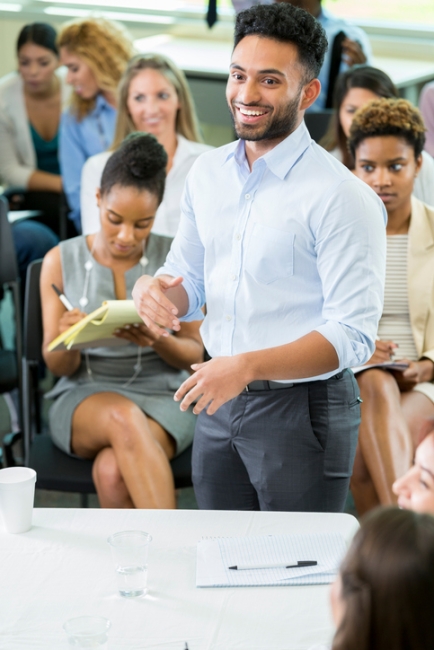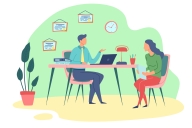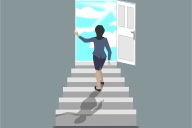You have /5 articles left.
Sign up for a free account or log in.

SDI Productions/E+ via Getty Images
In the calmest of times, graduate school is challenging. Graduate students contend with impostor syndrome (“When will they figure out I don’t know everything?”), uncertainty (“Will I get an academic job? Do I even want an academic job? What do I do with this degree?”) and transitions (“Should I move apartments again? Do I spend the summer on internship, at home, or in the lab?”). In a pandemic, all those uncertainties are magnified because they exist in broader uncertainty. Even the experts can’t tell us yet exactly what will happen or what we should do.
The spaces where graduate training most frequently occurs -- the lab and the classroom -- do not sufficiently address the challenges that graduate students face. To start to do so, we professors at Indiana University and Miami University of Ohio created a learning community about a year ago, supported by the National Science Foundation, to bolster professional development for graduate students. We wanted to establish a third space --- not the lab, not the classroom -- where faculty members and students can engage just a bit differently: across disciplinary lines, considering professional development intentionally and interacting without evaluative goals or threats.
Our interdisciplinary graduate student learning community focused on STEM doctoral students, and we intentionally designed it to offer a professional development experience for them. Our hope in establishing that community was that by engaging across interdisciplinary lines, graduate students would build their professional identities, learn to communicate to people outside their primary disciplines and build connections that stretched across campus beyond their home labs and departments. None of us could have possibly anticipated how important this community would become for both the students and faculty during the pandemic.
The faculty spent one year designing the curriculum and recruiting the first cohort of participants from the graduate programs in chemistry and psychology. We began meeting as a group in fall 2019, coming together in person every three weeks over the next few months. We discussed role conflict, key professional skills and how to develop them, and specific steps graduate students might take as they plan out their career, given a realistic assessment of their opportunities and their constraints. For example, we filled out individual development plans, or IDPs (and this IDP, too), and refined our SMART goals. We voiced fears and uncertainties, and we listened.
Early feedback from the graduate students indicated that this interdisciplinary professional development community was valuable because it provided, as one student said, “a space with other faculty and graduate students without concerns of evaluation. As graduate students, we are constantly evaluated, so it can be hard to be authentic and vulnerable about sharing and learning about experiences, both good and bad.” Another student observed that the learning community “offered “a strong support system where [we] genuinely felt valued and had the opportunity to reflect on how I can better myself now and for my future. It’s also reassuring to know that graduate students across departments may be struggling with the same issues as you and knowing that your experience can help someone else or vice versa.” As a community, we were finding ways to clarify our goals and understand how we fit into our different disciplines.
Pivoting for the Pandemic
Then, in early March, everything changed. Overnight, our home institution transitioned to remote instruction. We needed to pivot our community and pivot fast. We set aside our curriculum for the March meeting and instead chose to gather via Webex to simply check in with everyone. Pursuing our planned agenda was the last thing on everyone’s minds.
In April and May, we continued to find new ways to connect and provide this third space -- we pivoted again and again. We spent more time explicitly checking in with each other during our meetings and started a Slack channel for asynchronous communication. In addition, we held weekly drop-in video chats via Google Hangouts. We emailed and texted with the graduate students regularly. We made multiple options available to meet the graduate students’ individual preferences for community and support.
During all those pivots, the core practices and principles that launched this project became even more important to us and the students. We all faced -- and continue to face -- new challenges that no one imagined. The normal challenges are there but amplified, and new concerns have emerged. Throughout our time together, students and faculty members have had more questions than answers, more concerns than assurances. And yet simply voicing those questions and concerns together helped us all.
We have also shared concrete strategies to navigate the challenges. In the words of one student: “The opportunities for open discussions on [our] feelings/concerns as well as encouragement to involve in nonscience (nonacademic) related tasks such as walking, watching movies, listening to music, reaching out to people (mentors and loved ones) … helped [to] relieve stress, particularly during work-from-home because of COVID.” Consistent with the community norms before COVID-19, graduate students have also reported the benefits of “finding a broad range of mentors to provide multiple perspectives and forms of support.”
New Structured Opportunities
Graduate students can develop intellectually as instructors and thrive in the classroom, the first space. Graduate students can succeed in the research environment and benefit from mentors who provide guidance there, the second space. Yet each of those spaces can also threaten belonging and identity formation because they can limit what students see as potential next steps in their career. Institutions have an opportunity to intentionally transcend what exists in the other two spaces. Our own experience is that the third space we have created is crucial because it provides structured opportunities to learn from other students, other faculty and perspectives beyond their disciplines.
This third space offered a safe community in which to weather the pandemic. By removing the evaluation component of the faculty members involved in the third space, the students reported feeling a deep connection to each other and the faculty. Specifically, one of the students reported that the experience “offer[ed] a community experience to discuss professional aspects that are relevant to students of all areas -- while having the bonding elements of a shared program.” Another student also suggested that it was “a different way to learn and build our transferable skills from a traditional classroom. Sharing experiences with colleagues and mentors helps to see issues from two different points of view.”
As we pivoted in our program delivery and continued to connect with each other, some things became very clear in our new third space. It became even more apparent to all of us that the faculty do not have all the answers. (To be clear, the faculty never had “the answer.”) None of us know what the future holds for our country or for higher education. Yet as a community, through sharing and listening, we found some things that we do know, even in uncertain times.
That includes the recognition that taking small steps matters, and sometimes all we can do is the next modest task in front of us. With so many important issues demanding our attention, doing the small things can sometimes become difficult. We know that sometimes, major leaps require us to lower our own expectations for ourselves even on little things. We also know that, in the long run, each and every one of us has the capacity to succeed and that part of such success is identifying what is really important to us. We saw that sometimes these moments of crisis -- losing places, people or feelings of safety, even temporarily -- help us to uncover what really matters, who we are and what we love to do.
Creating a third space for graduate students and faculty mentors began as a research project to investigate student identity formation through building an interdisciplinary community and communicating science to nonexperts. While unexpected, this third space ultimately became crucial to navigating the multiple changes that have occurred over last year. It has provided the graduate students another place to build and practice transferable skills to clarify their priorities, to assess their constraints and opportunities, and to move forward.
All those skills are even more important during a pandemic. We developed as a graduate student learning community. We’ve found our third space -- and we hope that you can, too.








